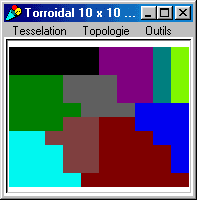
 |
|
|
|
PlotsRentalLand regrouping process by plots rentalFrançois Bousquet, Cirad ; Christophe Le Page, Cirad 
This model demonstrates the principles of Cormas communicating agents. Communicating agents have a mailbox and use a communicating channel to deliver messages in the mailboxes of the other agents belonging to their social network. In this exercice, 10 "farmer" agents are randomly located on a 10 x 10 spatial grid, each cell standing for a plot of land. Each farmer receives initially 10 plots, randomly chosen. He estimates the productivity of a plot according to its distance. The calculation on his potential income is based on this single criteria. Four ways of organizing the rentals of the plots have been implemented.
The three other scenarios are simulating a decentralized functionning: the exchanges of rental proposals do not go through the auctioneer anymore. It's rather a kind of mutual agreement that the farmers are looking for. In a first case, all the farmers know each others. Each one proposes his plots to the others. Then each one selects the best proposal for each of his plots, and finalizes the rental contracts. The result is the same than for the first scenario: as the information is symetric, the optimal solution is reached.
A last scenario emphasizes this asymetric of information, by assuming an asynchronous way of communication between the members of each group: as soon as a farmer receives an interesting proposal, he immediatly finalizes the contract without waiting for any other proposal. In this version with social and temporal asymetric of information, the land regrouping process is even less optimized.
|